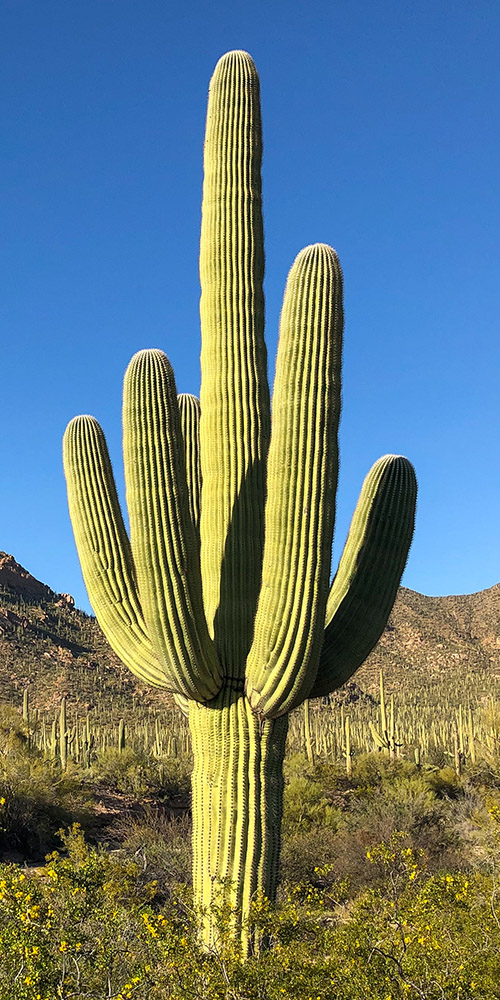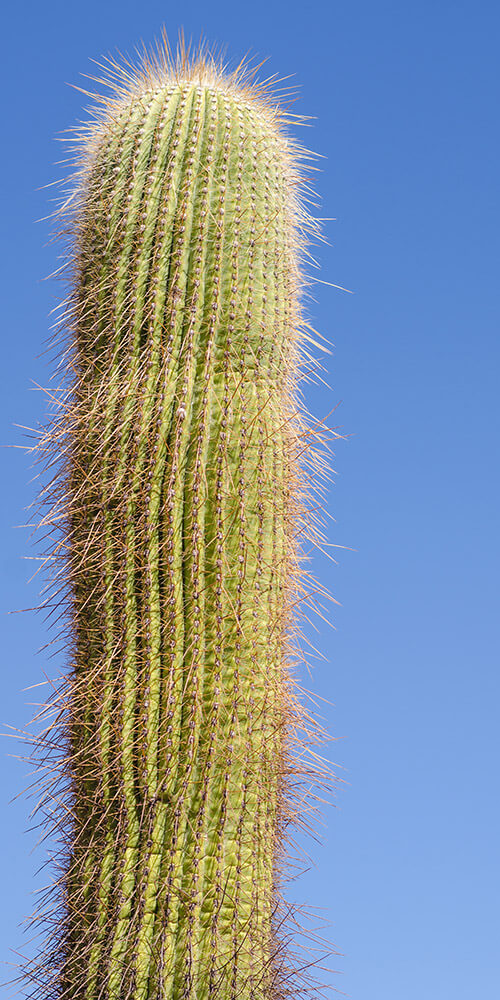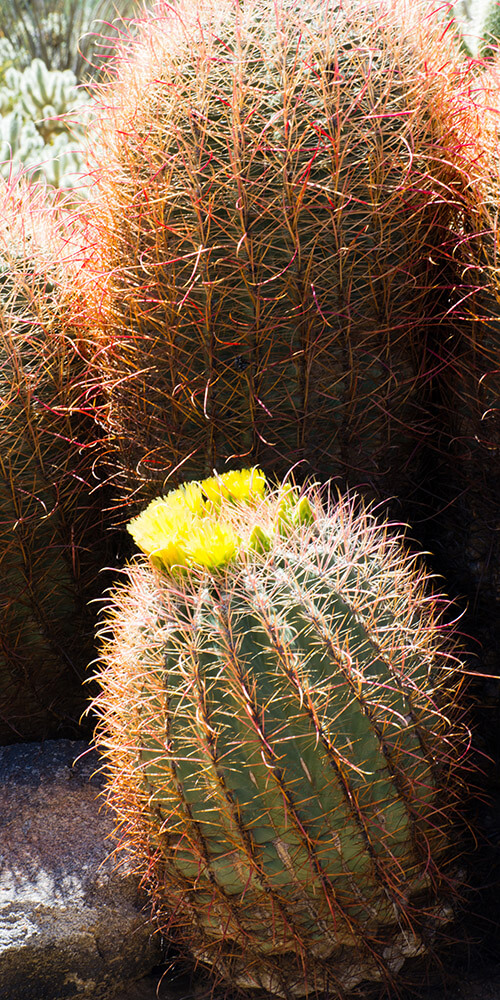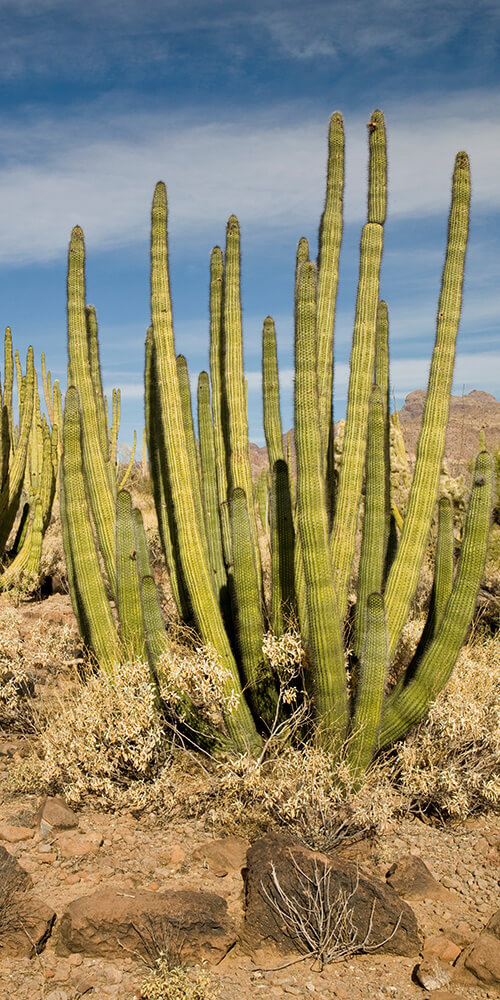Saguaro Cactus
The Saguaro Cactus (Carnegiea gigantea) is a iconic and iconic species of cactus native to the Sonoran Desert in the southwestern United States and Mexico. It is named after the Saguaro National Park in Arizona, which is home to a large population of these impressive cacti.
Saguaro Cactus are known for their tall, columnar shapes and striking white flowers, which bloom in the late spring and early summer. These cacti can grow up to 50 feet tall and can live for more than 200 years.
Saguaro Cactus grow best in arid, desert climates with plenty of sunlight and well-draining soil. They can tolerate temperatures as low as 20°F (-6°C) and as high as 120°F (49°C).
When caring for Saguaro Cactus, it is important to provide it with the right amount of water. Overwatering can lead to root rot, while under watering can cause the plant to wilt and become dehydrated. In general, it is best to allow the soil to dry out between waterings, and then water the plant deeply. During the hot summer months, it may be necessary to water the plant more frequently.
Saguaro Cactus also benefits from fertilization during the growing season, which typically runs from spring to fall. A balanced fertilizer, applied at half strength, can be used every two to four weeks.
It is important to protect Saguaro Cactus from freezing temperatures and strong winds, which can damage the plant’s stems. It is also important to protect the plant from pests such as mealybugs and scale insects, which can be controlled with a diluted solution of insecticidal soap.
Overall, Saguaro Cactus is a hardy and low-maintenance plant that is well suited for desert gardens and landscape design. With proper care, it can thrive and add a unique and striking visual element to any outdoor space.
Pricing
When we plant them, their Guaranteed for a Year, with Verified Automated Irrigation.
Soil Amendments are provided
You provide pre dug hole.
Gallery
Cardon Cactus
Cardon Cactus (Pachycereus pringlei) is a species of cactus native to the desert regions of Baja California, Mexico and the southwestern United States. It is known for its tall, columnar shape and large, spiny stems. Cardon Cactus can grow up to 50 feet tall and can live for more than 200 years.
Cardon Cactus grows best in arid, desert climates with plenty of sunlight and well-draining soil. It can tolerate temperatures as low as 20°F (-6°C) and as high as 120°F (49°C).
When caring for Cardon Cactus, it is important to provide it with the right amount of water. Overwatering can lead to root rot, while under watering can cause the plant to wilt and become dehydrated. In general, it is best to allow the soil to dry out between waterings, and then water the plant deeply. During the hot summer months, it may be necessary to water the plant more frequently.
Cardon Cactus also benefits from fertilization during the growing season, which typically runs from spring to fall. A balanced fertilizer, applied at half strength, can be used every two to four weeks.
It is important to protect Cardon Cactus from freezing temperatures and strong winds, which can damage the plant’s stems. It is also important to protect the plant from pests such as mealybugs and scale insects, which can be controlled with a diluted solution of insecticidal soap.
Overall, Cardon Cactus is a hardy and low-maintenance plant that is well suited for desert gardens and landscape design. With proper care, it can thrive and add a unique and striking visual element to any outdoor space.
Pricing
When we plant them, their Guaranteed for a Year, with Verified Automated Irrigation.
Soil Amendments are provided
You provide pre dug hole.
Gallery
Oregon Pipes Cactus
Organ Pipe Cactus (Stenocereus thurberi) is a species of cactus native to the Sonoran Desert in the southwestern United States and Mexico. It is named after the organ pipes found in churches due to the plant’s tall, upright stems that resemble organ pipes.
Organ Pipe Cactus grows best in arid, desert climates with plenty of sunlight and well-draining soil. It can tolerate temperatures as low as 20°F (-6°C) and as high as 120°F (49°C).
When caring for Organ Pipe Cactus, it is important to provide it with the right amount of water. Overwatering can lead to root rot, while under watering can cause the plant to wilt and become dehydrated. In general, it is best to allow the soil to dry out between waterings, and then water the plant deeply. During the hot summer months, it may be necessary to water the plant more frequently.
Organ Pipe Cactus also benefits from fertilization during the growing season, which typically runs from spring to fall. A balanced fertilizer, applied at half strength, can be used every two to four weeks.
It is important to protect Organ Pipe Cactus from freezing temperatures and strong winds, which can damage the plant’s stems. It is also important to protect the plant from pests such as mealybugs and scale insects, which can be controlled with a diluted solution of insecticidal soap.
Overall, Organ Pipe Cactus is a hardy and low-maintenance plant that is well suited for desert gardens and landscape design. With proper care, it can thrive and add a unique and striking visual element to any outdoor space.
Pricing
Multiple arms, 3-5 foot tall or larger. Delivery Available
When we plant them, their Guaranteed for a Year, with Verified Automated Irrigation.
Soil Amendments are provided
You provide pre dug hole.
Gallery
Barrel Cactus
Barrel Cactus (Ferocactus spp.) is a group of cactus species native to the desert regions of the southwestern United States and Mexico. They are named after their round, barrel-like shape and are known for their thick, spiny stems and bright flowers.
There are several different species of Barrel Cactus, each with its own unique characteristics. Some common species include Ferocactus cylindraceus, Ferocactus emoryi, and Ferocactus wislizeni.
Barrel Cactus grow best in arid, desert climates with plenty of sunlight and well-draining soil. They can tolerate temperatures as low as 20°F (-6°C) and as high as 120°F (49°C).
When caring for Barrel Cactus, it is important to provide it with the right amount of water. Overwatering can lead to root rot, while under watering can cause the plant to wilt and become dehydrated. In general, it is best to allow the soil to dry out between waterings, and then water the plant deeply. During the hot summer months, it may be necessary to water the plant more frequently.
Barrel Cactus also benefits from fertilization during the growing season, which typically runs from spring to fall. A balanced fertilizer, applied at half strength, can be used every two to four weeks.
It is important to protect Barrel Cactus from freezing temperatures and strong winds, which can damage the plant’s stems. It is also important to protect the plant from pests such as mealybugs and scale insects, which can be controlled with a diluted solution of insecticidal soap.
Overall, Barrel Cactus is a hardy and low-maintenance plant that is well suited for desert gardens and landscape design. With proper care, it can thrive and add a unique and striking visual element to any outdoor space.
Pricing
Starting at $30 Basketball Size
Large Starting at $50
When we plant them, their Guaranteed for a Year, with Verified Automated Irrigation.
Soil Amendments are provided
You provide pre dug hole.
Gallery
Prickly Pear Cactus
Prickly Pear Cactus (Opuntia spp.) is a group of cactus species native to the desert regions of the southwestern United States and Mexico. They are named after their round, pear-shaped pads and are known for their bright, colorful flowers and edible fruit.
There are several different species of Prickly Pear Cactus, each with its own unique characteristics. Some common species include Opuntia ficus-indica, Opuntia engelmannii, and Opuntia humifusa.
Prickly Pear Cactus grow best in arid, desert climates with plenty of sunlight and well-draining soil. They can tolerate temperatures as low as 20°F (-6°C) and as high as 120°F (49°C).
When caring for Prickly Pear Cactus, it is important to provide it with the right amount of water. Overwatering can lead to root rot, while under watering can cause the plant to wilt and become dehydrated. In general, it is best to allow the soil to dry out between waterings, and then water the plant deeply. During the hot summer months, it may be necessary to water the plant more frequently.
Prickly Pear Cactus also benefits from fertilization during the growing season, which typically runs from spring to fall. A balanced fertilizer, applied at half strength, can be used every two to four weeks.
It is important to protect Prickly Pear Cactus from freezing temperatures and strong winds, which can damage the plant’s stems. It is also important to protect the plant from pests such as mealybugs and scale insects, which can be controlled with a diluted solution of insecticidal soap.
Overall, Prickly Pear Cactus is a hardy and low-maintenance plant that is well suited for desert gardens and landscape design. With proper care, it can thrive and add a unique and striking visual element to any outdoor space.
Pricing
Gallery
Senita Cactus
Senita Cactus (Lophocereus schottii var. senilis) is a species of cactus native to the Sonoran Desert in the southwestern United States and Mexico. It is also known as Old Man Cactus or Senita Puffball due to the white, woolly hairs that cover its stems and resemble the beard of an old man.
Senita Cactus grows best in arid, desert climates with plenty of sunlight and well-draining soil. It can tolerate temperatures as low as 20°F (-6°C) and as high as 120°F (49°C).
When caring for Senita Cactus, it is important to provide it with the right amount of water. Overwatering can lead to root rot, while under watering can cause the plant to wilt and become dehydrated. In general, it is best to allow the soil to dry out between waterings, and then water the plant deeply. During the hot summer months, it may be necessary to water the plant more frequently.
Senita Cactus also benefits from fertilization during the growing season, which typically runs from spring to fall. A balanced fertilizer, applied at half strength, can be used every two to four weeks.
It is important to protect Senita Cactus from freezing temperatures and strong winds, which can damage the plant’s stems. It is also important to protect the plant from pests such as mealybugs and scale insects, which can be controlled with a diluted solution of insecticidal soap.
Overall, Senita Cactus is a hardy and low-maintenance plant that is well suited for desert gardens and landscape design. With proper care, it can thrive and add a unique and striking visual element to any outdoor space.
Pricing
Multi arms/trunks 3 – 5 Tall
Large Clusters Starting at $350
When we plant them, their Guaranteed for a Year, with Verified Automated Irrigation.
Soil Amendments are provided
You provide pre dug hole.
Gallery






